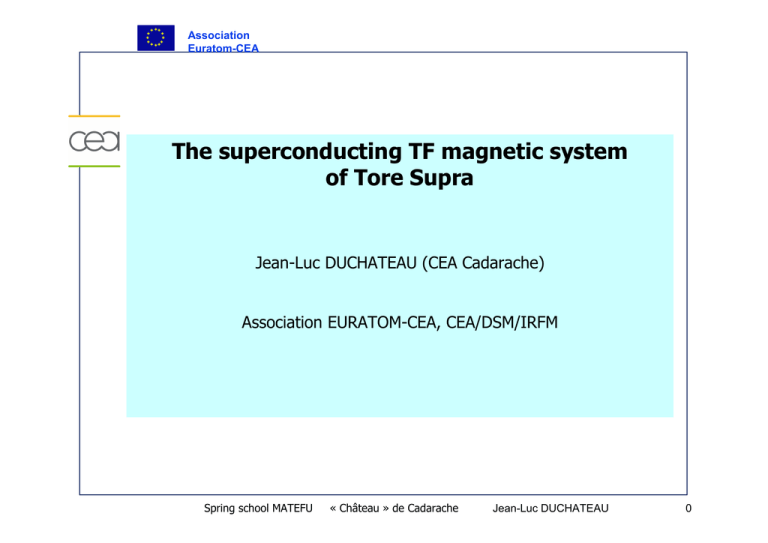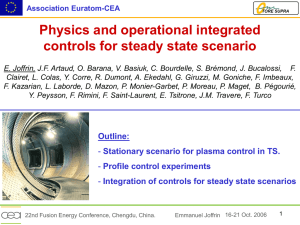The superconducting TF magnetic system of Tore Supra - IRFM
advertisement

Association Euratom-CEA The superconducting TF magnetic system of Tore Supra Jean-Luc DUCHATEAU (CEA Cadarache) Association EURATOM-CEA, CEA/DSM/IRFM Spring school MATEFU « Château » de Cadarache Jean-Luc DUCHATEAU 0 Association Euratom-CEA Spring school MATEFU « Château » de Cadarache Jean-Luc DUCHATEAU 1 Association Euratom-CEA 1. Introduction TORE SUPRA TF system contribution The revolution of superfluid helium 1.8 K Introduction of a new type of refrigeration for sc on an industrial level Thousands of litres in TS (1988) Hundredths of thousands litres in LHC (2007) ! TORE SUPRA Cryoelectricity for magnet systems can be handled together with Plasma Physics in large fusion experiments Spring school MATEFU « Château » de Cadarache Jean-Luc DUCHATEAU 2 Association Euratom-CEA Introduction GENERAL OBSERVATIONS The toroidal field system of TORE SUPRA is one of the largest superconducting system in operation. It is operated near its nominal characteristics since November 1989. The system is operated daily, the field is increased typically in the morning (8 am), maintained during the whole day long and decreased in the evening around 8 pm. Very good reliability and availability of the refrigerator including for the first time industrial quantities of superfluid helium thanks to the Claudet bath. The non cycled operation of the magnet leads to a simplification in the preparation of the shot. Most of the conventional toroidal field systems of large tokamaks experience on the long run problems connected to the cycling and resulting mechanical fatigue. Spring school MATEFU « Château » de Cadarache Jean-Luc DUCHATEAU 3 Association Euratom-CEA Introduction The Tore Supra TF magnet during assembly Spring school MATEFU « Château » de Cadarache Jean-Luc DUCHATEAU 4 Association Euratom-CEA Mains aspects of Tore Supra design Figure shows one module representing 1/6 th of the magnet. It is made of two parts: the inner vault (or coil nose) is massive, the outer one (or coil ears) is made of a divided structure. The coils are electrically insulated from each other by glass epoxy plates while being mechanically locked by insulated shear keys. A module of the Tore Supra TF system (1/sixth of the TF system) Spring school MATEFU « Château » de Cadarache Jean-Luc DUCHATEAU 5 Association Euratom-CEA Mains aspects of Tore Supra design The machine is composed of identical modules representing 1/6 th of the full torus. The modules, assembled separately, contain the complete succession of torus: inner vessel, thermal shield, magnet system, outer thermal shield, and outer cryostat. After assembly, each torus behaves as a rigid torus, so that forces acting on it are self-restrained. The implication and the advantage is that only the weight has to be supported by components at a different temperature. Spring school MATEFU « Château » de Cadarache Jean-Luc DUCHATEAU 6 Association Euratom-CEA Mains aspects of Tore Supra design bare conductors in superfluid helium ! Superfluid helium (1.8 K) in thin casing Supercritical helium (4.5 K) in thick casing channels Tore Supra TF coil structure Spring school MATEFU « Château » de Cadarache Jean-Luc DUCHATEAU 7 Association Euratom-CEA Mains aspects of Tore Supra design At the bath temperature (1.8 K), at 1400 A and 9 T the conductor satisfies stability requirements of two kinds: In case of a plasma current disruption, the conductor is subject to field variations in the range of 0.6 T with an associated time constant due to the steel casings of about 10-20 ms. The conductor must not reach at any point a temperature greater than the current sharing temperature. In case of a sudden temperature increase caused by accidental perturbation the conductor temperature can increase above the critical temperature and recover after having reached the following typical values: 30 K for a localized perturbation under one spacer, and 15 K if a whole pancake is affected. Spring school MATEFU « Château » de Cadarache Jean-Luc DUCHATEAU 8 Association Euratom-CEA Mains aspects of Tore Supra design As a consequence, in the TF coils, the operating point was chosen such as to absorb perturbations and plasma current disruptions. On the load line the critical current is reached at 4.2 K, for the nominal TS values (1400 A and 9 T). Local losses in the conductor in operation and in particular during disruption (∆B=0.5 T within 10 to 20 ms) must remain sufficiently small to be absorbed by the very large enthalpy of superfluid helium between 1.8 K and 2.16 K (Tλ): 3 105 J/m3 . Not all the conductor lengths are in direct contact with superfluid helium. Thermal temperature gradients arise during heat extraction in the non-wetted parts of the conductor. The current sharing temperature of the project has been adjusted to take into account with a margin the highest temperature during the process of heat extraction. This temperature has been estimated around 3.4 K, which means that the margin compared to the current sharing temperature of 4.2 K is 0.8 K. Spring school MATEFU « Château » de Cadarache Jean-Luc DUCHATEAU 9 Association Euratom-CEA Mains aspects of Tore Supra design Tore Supra TF system conductor (2.8 x 5.6 mm2) Spring school MATEFU « Château » de Cadarache Jean-Luc DUCHATEAU 10 Association Euratom-CEA Mains aspects of Tore Supra design 4000 load line 1400 A, 9 T 3500 Ic (T=4.2 K) Current [A] 3000 Ic(T=1.8K) 2500 2.4 K Temperature margin on the TF system of TS on all the coils except BT19 2000 1500 1000 500 0 6 7 8 9 10 11 Field [T] 12 13 14 Large margin Operation point Critical point Spring school MATEFU « Château » de Cadarache Jean-Luc DUCHATEAU 11 Association Euratom-CEA Spring school MATEFU « Château » de Cadarache Jean-Luc DUCHATEAU 12 Association Euratom-CEA Phase diagram of water (To be compared with helium) Spring school MATEFU « Château » de Cadarache Jean-Luc DUCHATEAU 13 Association Euratom-CEA Acceptance tests Before assembly at CEA Saclay The acceptance tests of the coils before assembly were performed at CEA Saclay. Three objectives have been assigned to these experiments: Test of the prototype coil which was specially equipped with small heaters to induce a quench, and voltage taps to study the propagation of the normal zone. Test of the 18 coils of the torus Test of the equipment used for cooling and the electrical systems as pumps, superfluid heat exchangers, safety valves, leads and electrotechnical equipments. Spring school MATEFU « Château » de Cadarache Jean-Luc DUCHATEAU 14 Association Euratom-CEA Acceptance tests Test of the prototype coil at CEA Saclay - Observation on strain gages during cooling down - Increase of current up to nominal current ( 1400 A) - Fast discharge with a time constant of 14 s (1750 V) - Initiation of a quench by a resistive heater and observation of the quench characteristics (main result: quench propagation within 3 s) Main problems - burning of a switch (wrong time control in the electronic system - damage to the current breaker due to stray magnetic field - transition because of operation at very low pressure (saturation pressure) (failure of cold valve opening during cooling down) Spring school MATEFU « Château » de Cadarache Jean-Luc DUCHATEAU 15 Association Euratom-CEA Acceptance tests Tests of the series coils at CEA Saclay tests before energizing - 8 kV dc to the ground for one minute at room temperature - 4 kV to the ground in superfluid helium with current leads connected - tightness tests of the thin casing after cooling down tests in current - first check tests at 120 A - 1400 A (5.4 T) with no training in all coils (9 T in TORE SUPRA) - 1750 V across the coil during FSD (half nominal voltage) Spring school MATEFU « Château » de Cadarache Jean-Luc DUCHATEAU 16 Association Euratom-CEA Acceptance tests Tests of the whole system at CEA Cadarache - insulation tests - tightness tests (thin casing), - tests at 120 A, - operation at reduced current 600 A associated with first campaign of TORE SUPRA. → short circuit on BT17 Replacement of BT17 by prototype coil transformed in spare coil - change of safety system principle - update of quench detection system and of system monitoring - acceptance tests by step (120 A, 600 A, 800 A, 1000 A, 1250 A, 1450 A) FSD at each step - observation of abnormal behaviour on BT13 with eventually quench during 1450 A FSD. Insulation tests after each (warm up – cooling down cycle) of the system : test to the ground of each coil, capacitor discharge on each coil with comparison with previous results, strain measurements (gauges on thick casings) on current cycle. Spring school MATEFU « Château » de Cadarache Jean-Luc DUCHATEAU 17 Association Euratom-CEA Protection in case of a quench The detectors V Voltage (V) P Cold pressure (Pa) N Cold Liquid In cold valve region (K) T Temperature near Current lead cryostat (K) I Ground current (A) Thereshold level <2. <2. 105 >1.95 <2.05 50. Time delay (s) 1. 0.5 2 2. 0.5 Spring school MATEFU « Château » de Cadarache Jean-Luc DUCHATEAU 18 Association Euratom-CEA Protection Location of the two temperature T detections N Spring school MATEFU « Château » de Cadarache Jean-Luc DUCHATEAU 19 Association Euratom-CEA Protection Evolution of the discharge circuit after damage of coil BT17 (two cells) Rs=2.5 Ω Original protection design Rcoil=0.5Ω Within 3s in case of a quench Rs=0.417 Ω Rc=0.833 Ω New protection design Spring school MATEFU « Château » de Cadarache Jean-Luc DUCHATEAU 20 Association Euratom-CEA Protection Tore Supra TF system FSD resistor Spring school MATEFU « Château » de Cadarache Jean-Luc DUCHATEAU 21 Association Euratom-CEA Protection The rearrangement of the discharge circuit from a series circuit to a series/parallel circuit has allowed to decrease the voltage across the coil by a factor of ten. - in case of a FSD without a quench the voltage across the coils is low (390 V instead of 3500 V) and the time constant of the discharge is long 122 s. - in case of a real quench, the electrical circuit is affected by the resistance of the quench coil which is rapidly (3s) at a value around 0.5 Ω decreasing automatically the time constant discharge of the quenched coils around 14s, which is adequate to protect it. Unbalance of current between coils and associated shear forces have been studied and accepted. Spring school MATEFU « Château » de Cadarache Jean-Luc DUCHATEAU 22 Association Euratom-CEA Unique quench in TORE SUPRA Coil BT04 Spring school MATEFU « Château » de Cadarache Jean-Luc DUCHATEAU 23 Association Euratom-CEA Unique quench in TORE SUPRA Coil BT04 Spring school MATEFU « Château » de Cadarache Jean-Luc DUCHATEAU 24 Association Euratom-CEA Protection Check of the quench detection system This check is performed daily and automatically on the three main quench detections (T,P,V). As concerns the temperature detection the alarm must be triggered on every coil during the night warming up. This transition is automatically checked afterwards every day, attesting the good behaviour of the whole detection system. For the pressure and the voltage detections the test is made by simulating a quench signal and checking that it is well detected. An additional test is made on the voltage detection to ensure that the time delay is well respected and that the detection cannot be triggered by a simple electrical noise. Spring school MATEFU « Château » de Cadarache Jean-Luc DUCHATEAU 25 Association Euratom-CEA Status of the Tore Supra TF system 1982-1988 → coil manufacture and magnet assembly all coils tested up to nominal current (1400 A) at Saclay 1988 → 1989 start of operation short circuit in BT17 during a fast safety discharge replacement of BT17 by spare coil BT19 acceptance tests of TF coils up to 1450 A (9.3 T) → quench of BT13 during fast safety discharge (FSD) → limitation of operating current to 1250 A → temperature increase observed in BT13 during FSD 1995 → 2002 disappearance of defect on BT13 no more temperature increase in BT13 during FSD continuous data acquisition system Spring school MATEFU « Château » de Cadarache Jean-Luc DUCHATEAU 26 Association Euratom-CEA 2.15 6.4 2.10 6.2 BT13 Temperature Coil temperature (K) 2.05 2.00 BT16, BT17 Temperatures 1.95 6 5.8 5.6 1.90 5.4 1.85 5.2 1.80 1.75 5 Thick casing coil helium temperature 4.8 1.70 4.6 1.65 4.4 -500 1500 3500 5500 7500 9500 Time (s) Spring school MATEFU « Château » de Cadarache Thick casing helium temperature (K) Status of the TORE SUPRA TF system No more apparent problem on BT13 Temperature increase in coils during FSD (2003) No special cryogenic impact of FSD in BT13 in comparison with the other coils Green light for TF operation 1.8 K Jean-Luc DUCHATEAU 27 Association Euratom-CEA Normal operation in TORE SUPRA Thermal cycling: 16 thermal cycling were performed since 1988 for the TF system (300 K→ 1.8 K→300 K) Plasma discharges: 25500 plasma discharges have been performed. Number of TF cycles 800 700 TORE SUPRA TF activity Since 1988 11000 hours of operation 600 500 400 300 200 100 0 0/600 600/900 900/1200 >1200 Range of TF current (A) Spring school MATEFU « Château » de Cadarache Jean-Luc DUCHATEAU 28 Association Euratom-CEA Normal operation in TORE SUPRA 1.2 Since 2003 continuous data acquisition and record on TF sensors available 1.80 TF system current 1.78 1.76 Cleaning Plasma Plasma discharges discharges Long Plasma discharges 0.8 1.74 1.72 0.6 1.70 BT15 Temperature 0.4 1.68 1.66 BT15 coil temperature (K) Plasma current (MA) and TF current (kA) 1 Better system monitoring is possible 1.64 0.2 1.62 0 1.60 5 7 9 11 13 15 17 19 21 23 Time ( h ) Temperature increase linked to TF current increase (0.06 K) Spring school MATEFU Green light for TF operation 1.8 K « Château » de Cadarache BT 15 temperature during one day of operation Jean-Luc DUCHATEAU 29 Association Euratom-CEA Normal operation in TORE SUPRA 1.2 5.00 Plasma current (MA) and TF current(kA) 1 Cleaning Plasma discharges Plasma discharges 0.8 0.6 4.90 Long Plasma discharges 4.80 Thick casing helium temperature 4.70 0.4 4.60 0.2 4.50 0 Thick casing helium temperature (K) TF system current Thick casing helium temperature during one day of operation 4.40 5 7 9 11 13 15 17 19 21 23 Time ( h ) Temperature increase linked to cleaning plasma discharges Spring school MATEFU « Château » de Cadarache Jean-Luc DUCHATEAU 30 Association Euratom-CEA Normal operation in TORE SUPRA Green light for TF operation 1.8 K TS#31828 Plasma disruption 1600 1400 1200 1000 800 1.725 5.5 400 5.4 Thick casing helium temperature (K) IP (kA) 600 1.72 5.3 200 1.715 5.1 5 1.71 Coil temperature 4.9 1.705 4.8 4.7 Thick casing helium temperature 4.6 1.7 4.5 -50 1.695 50 150 250 350 450 time (s) Spring school MATEFU « Château » de Cadarache Coil temperature (K) 0 5.2 -200 dIP/dt (MA/s) -400 2.69 2.70 2.71 2.72 2.73 2.74 s Cryogenic impact due to a disruption from 1.7 MA 0.02 K for coil 0.83 K for thick casing Jean-Luc DUCHATEAU 31 Association Euratom-CEA Main problems in operation: FAST SAFETY DISCHARGES Every year several FSD in the TF system. They are not associated to a quench of any coil. coil A lot of attention was devoted all along these 16 years to decrease the number of these FSD. During FSD the coils experience the largest voltage in operation (320 V corresponding to 1400 A). The weak point of the system is the presence of bare conductors and the associated possibility of short circuits → FSD have to be avoided FSD induces a thermal load on the system which need on average 2h30 to recover and the operation is correspondingly interrupted. Part of the FSD are associated to electrical perturbations during plasma heating. To mitigate the perturbation on the Tokamak operation an important effort was devoted to make the protection system of TS magnets more insensitive to electrical perturbations. Spring school MATEFU « Château » de Cadarache Jean-Luc DUCHATEAU 32 Association Euratom-CEA 2.15 6.4 2.10 6.2 BT13 Temperature Coil temperature (K) 2.05 2.00 BT16, BT17 Temperatures 1.95 6 5.8 5.6 1.90 5.4 1.85 5.2 1.80 1.75 5 Thick casing coil helium temperature 4.8 1.70 4.6 1.65 4.4 -500 1500 3500 5500 7500 Thick casing helium temperature (K) FAST SAFETY DISCHARGES 9500 Time (s) Spring school MATEFU « Château » de Cadarache Jean-Luc DUCHATEAU 33 Association Euratom-CEA 12 Number of TF current cycles 3500 10 8 6 4 2 3000 2500 2000 1500 1000 500 19 8 19 9 9 19 0 9 19 1 9 19 2 9 19 3 9 19 4 9 19 5 9 19 6 9 19 7 9 19 8 9 20 9 0 20 0 0 20 1 0 20 2 03 0 0 19 89 19 90 19 9 19 1 92 19 93 19 9 19 4 95 19 9 19 6 97 19 98 19 9 20 9 01 20 02 20 03 Number of Fast safety discharges Main problems in operation: FAST SAFETY DISCHARGES Mitigation of perturbation Using time delays on alarms as long as possible without affecting the protection of the coils in case of a real quench. Important effort in sensors conditioning→ → general protection optimisation Spring school MATEFU « Château » de Cadarache Jean-Luc DUCHATEAU 34 Association Euratom-CEA FAST SAFETY DISCHARGES Unidentified Command Control Storm Origin of the FSD Pow er supply NBI ICRH Safety system Cryoplant 0 2 4 6 8 10 12 Temperature increase linked to cleaning plasma discharges Spring school MATEFU « Château » de Cadarache Jean-Luc DUCHATEAU 35 Association Euratom-CEA The cryogenic system of TORE SUPRA Power associated to operation modes 77 K Power 6000 l of N2 Per day 4.5 K power 1.8 K power Total electrical consumption Magnet operation day 10 kW 900 W 300 W 1100 kW Nights between operation days 10 kW 700 W 0 900 kW Week ends 10 kW 700 W 0 900 kW 0 0 300 kW One week 10 kW shut down Spring school MATEFU « Château » de Cadarache Cryoplant fully automatic operated by a team of 12 people 0.5 Meuros/year Excluding staff and energy Jean-Luc DUCHATEAU 36 Association Euratom-CEA The cryogenic system of TORE SUPRA The major tendency of the cryoplant ageing Although the preventive maintenance of the compressor units gives a good availability of the refrigerator, after 16 years of operation we can identify the major following tendencies for the cryoplant ageing : - a loss of electrical insulation of many temperature sensors located in the depth of the cryostats. - a drift of adjustment of the electronic components dedicated to the magnetic bearings of the cold compressors. - air leaks in the cryostat vacuum vessel due to the tightness seal ageing. Spring school MATEFU « Château » de Cadarache Jean-Luc DUCHATEAU 37 Association Euratom-CEA Can the TF magnet experience of TS be useful for ITER ? How far are TORE SUPRA and ITER TF systems comparable ? TORE SUPRA TF system ITER TF system 600 MJ 1400 A 500 V Superfluid bath No radial plates 40 GJ 68 kA 10 kV Forced flow cooling Conductors in radial plates TORE SUPRA conductor 2.8 x 5.6 mm NbTi ITER model coils conductors 51 x 51 mm ¢=40.7 mm Nb3Sn Spring school MATEFU « Château » de Cadarache Jean-Luc DUCHATEAU 38 Association Euratom-CEA How far are TORE SUPRA and ITER TF systems comparable ? TORE SUPRA operation cannot be simply extrapolated to ITER Forced flow cooling introduces a completely new type of refrigeration This is linked to very high voltage monitoring Forced flow cooling induces a different kind of protection strategy Radial plates solution impose a more difficult operation mode with cold eddy current. FSD contrary to the situation in TS induces a quench Specific solutions have to be developed for ITER Spring school MATEFU « Château » de Cadarache Jean-Luc DUCHATEAU 39 Association Euratom-CEA How TORE SUPRA experience on TF system is useful for ITER magnet system ? Practical demonstration during this 16 years that Plasma Physics is possible with superconducting magnets. ITER decision could probably not be possible without this experience This experience has been transferred during ITER R&D programs for ITER conductor design and coils design by CEA magnet team. Still to be done Experience in TS can help • Design of simple and robust protection and monitoring system specificities such as plates and related impact on cryogenics during FSD • Double contradictory objective → Avoid quench system (40 GJ) (only one quench since 1988 in TS !) → Minimize number and effect of FSD because of plates • Detailed magnet operation concept, • Refrigeration dimensioning as a function operation specifications Spring school MATEFU « Château » de Cadarache Jean-Luc DUCHATEAU 40 Association Euratom-CEA Conclusion The TORE SUPRA Tokamak is the first important meeting between Superconductivity and Plasma Physics on a large scale. This experience has demonstrated that superconducting magnets can be operated successfully on the long term with plasma physics. Far from being a burden, the continuous operation of the TF system is a simplification in the preparation of the plasma discharges. No significant heat load is associated to long shots. The non pulsed operation of this large magnet system is also an advantage as concerns the mechanics which can have an impact on ageing of insulation. Overall, despite the differences in design and size, the accumulated experience over 16 years of operation is certainly a useful tool to prepare the manufacture and the operation of the ITER magnets. Spring school MATEFU « Château » de Cadarache Jean-Luc DUCHATEAU 41



